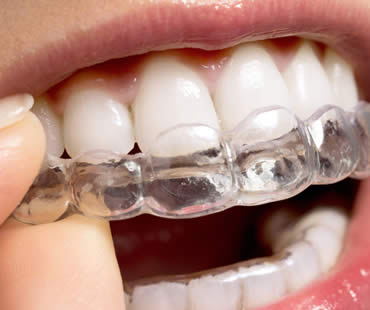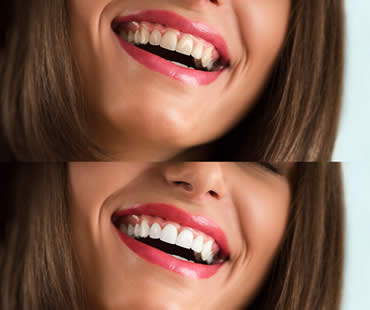
Blog, Dental Topics 2, Veneers
One of the most common procedures in cosmetic dentistry today is dental veneers. Many types of problems can be remedied with veneers, such as teeth that are chipped, broken, gapped, misshapen, or discolored. A veneer is a very thin shell usually made of porcelain that is bonded to the fronts of teeth to hide flaws.
Benefits:
One of the best things about dental veneers is that they immediately transform your smile the minute they are placed. They are very natural-looking because the porcelain reflects light in the same way as real teeth. Discolored or stained teeth are erased by veneers that are created in the shade you choose. Porcelain resists stains so you no longer have to worry about discoloration. You get to keep your original teeth since veneers are attached directly to them. Veneers are not only an attractive choice, they are also strong and durable.
Procedure:
The process for getting dental veneers takes two or three appointments. At the first visit, you will have an examination and X-rays to learn if you are a good candidate for veneers. If this type of restoration is suitable for you and will help you achieve your goals, your dentist can customize your smile based on your facial features, coloring, complexion, and other characteristics. A mold will be taken of your mouth and sent to a dental laboratory for your veneers to be made. When they are ready in about a week, you will return to the dental office to have them attached to check for things like fit and color. The veneers will then be permanently bonded to your teeth and final modifications will be completed.
Care:
Your normal oral hygiene routine can be continued, including gentle regular brushing with a soft toothbrush and daily flossing. Regular dental checkups every six months should be maintained for checkups and cleanings. Avoid chewing or biting on hard items so that your veneers will not chip or break. If you follow these guidelines, your veneers should last a very long time.
If you live in the Gaithersburg area contact us today

Blog, Dental Topics 2, Kids Dentistry
Kids don’t always play it safe or make the best decisions when it comes to protecting their teeth. Tooth decay and mouth injuries are just a couple of things parents must worry about for their kids, whether it’s the elementary school or college years. Here are some simple ways that parents can teach their kids to protect their teeth.
Limit sports and energy drinks.
Sports and energy drinks are both heavily marketed toward today’s youth. It is true that sports drinks help replace electrolytes during exercise, but many people drink them too much or outside the exercise realm. Experts have deemed sports drinks to be unnecessary in the lunchroom or as a snack on the playground. The high acid levels in these drinks can erode tooth enamel, with energy drinks determined to cause twice as much damage. It is recommended to save sports drinks for very strenuous activities, and instead stick with water for hydration and refreshment without the negative effects.
Insist upon mouthguards.
Parents should provide mouthguards for kids in nearly any sport, even if it isn’t considered mandatory by the school or team. Mouthguards can prevent chips, fractures, or knockouts of teeth, as well as protect the soft tissues of the mouth. According to research estimates, 3 million teeth were knocked out in youth sports in 2011. Dentists suggest that athletes who don’t wear mouthguards are 60 times more likely to sustain oral injury. Inexpensive basic mouthguards or the boil-and-bite variety are available at sporting goods stores, or customized mouthguards can be purchased through your dentist.
Say no to oral piercings.
Although it applies primarily to teenagers and older, the Academy of General Dentistry advises against oral piercing for active people. Those with piercings should remove them before participating in sports, because puncture wounds can lead to infections related to increased blood flow and breathing rates during exercise. If your child is considering and oral piercing, make sure you discuss the risks and need for removal during physical activity.
We treat patients from Gaithersburg and the surrounding area

Blog, Dental Topics 2, Invisalign
Feeling unhappy with your smile can leave you wondering how you can obtain a stylish new look. Instead of being turned off by traditional treatments like metal braces, consider the modern approach of Invisalign clear aligners.
This revolutionary treatment involves wearing clear plastic aligners made just for you to gently move your teeth into better positions. They are practically invisible and are removable for eating and cleaning. The smooth material makes them comfortable, and they do not have any bothersome metal brackets or wires.
If you are interested in Invisalign treatment, the first step is finding an orthodontist or dentist who provides this service. Not every professional is trained in this method, so look for a certified provider of Invisalign. Once you identify your choices, select the provider who is convenient, experienced and gives you confidence in your treatment.
Your initial appointment will allow the professional to examine your mouth to make sure you are a good candidate for Invisalign. Unless you have poor oral health or severe teeth problems, most people qualify for Invisalign. The doctor will then prepare a treatment plan to guide your case and create your aligners. An impression of your teeth, X-rays, and photos will be taken to help with the process. A 3-dimensional image will be developed to help with your treatment plan, and also to allow you to see how your teeth will improve at each stage of the process and provide a timeline.
Once your aligners are ready, you’ll begin wearing them for about two weeks at a time and then switch to a different set of aligners in the series your doctor gives you. A checkup at the office is required about every six weeks to monitor your progress and get more aligners in the series as needed. The process will continue until treatment is complete, often in about one year. Then you’ll be ready to show off your brand new smile thanks to Invisalign.
We treat patients from Gaithersburg and the surrounding area

Blog, Dental Topics 4, Invisalign
A beautiful smile can boost confidence, make a great first impression, and improve overall health.
A beautiful smile can boost confidence, make a great first impression, and improve overall health. One way to achieve a winning smile is through Invisalign treatment. Invisalign has become a popular alternative to traditional braces due to its convenience and discreet appearance.
Explanation of Invisalign as a dental treatment
Invisalign is an orthodontic treatment that uses clear aligners to gradually move teeth into their desired position. The aligners are custom-made for each patient using 3D imaging technology. They are worn over the teeth and are virtually invisible, making them a popular choice for adults who may feel self-conscious about wearing traditional metal braces.
Importance of having a beautiful smile
Having a beautiful smile can have positive effects on both physical and emotional health. A straighter smile can improve oral health by making it easier to brush and floss effectively, reducing the risk of tooth decay and gum disease. Additionally, smiling releases endorphins that can boost mood and reduce stress levels.
People who feel confident in their smiles are more likely to succeed in social situations such as job interviews or dating scenarios. Now that we have an understanding of what Invisalign is, its history, and why having a beautiful smile is important let’s dive deeper into how exactly this revolutionary dental treatment works in section II – “What is Invisalign?”
What is Invisalign?
Invisalign is an orthodontic treatment that uses clear, removable aligners to straighten teeth and correct bite issues. These aligners are made of a special thermoplastic material that is custom-fitted to your teeth. Invisalign works by applying a controlled amount of force on your teeth to move them into the desired position.
The Invisalign Treatment
Invisalign treatment is designed to be a more subtle alternative to traditional metal braces. The custom-made aligners are virtually invisible, allowing patients to undergo orthodontic treatment without feeling self-conscious about their appearance. In addition, the aligners can be removed for eating, drinking, brushing, and flossing which makes them far more convenient than traditional braces.
Comparison to Traditional Braces
Compared with conventional metal braces, Invisalign provides several advantages. First and foremost being the aesthetics – since they are almost invisible on your teeth, people won’t even know you’re wearing them!
Additionally, patients who choose Invisalign enjoy greater comfort due to the materials used in creating the aligners- there’s no metal or wires that can irritate soft tissues in your mouth as with traditional metal braces. Unlike conventional braces which require frequent visits for adjustments or repairs – Invisalign generally requires much fewer office visits.
How It Works
Before starting treatment and getting fitted with your first set of custom-made aligners, you will meet with a dentist who will evaluate your teeth and determine how many sets of aligners you’ll need over the course of treatment. Each set of clear plastic trays gradually moves your teeth toward their final positions. You’ll wear each set for 20-22 hours per day for two weeks before switching to a new one (as prescribed by your doctor).
Every time you switch to a new set of aligners, your teeth will move slightly closer to their final position. Over time (usually 12-18 months), the Invisalign aligners will gradually shift your teeth into their proper place for an improved, healthy smile.
Benefits of Invisalign
Aesthetics and Appearance
One of the primary benefits of Invisalign is that the aligners are virtually invisible. Unlike traditional metal braces, which can be unsightly and noticeable, Invisalign aligners are made from clear plastic that blends in with your teeth. This means that people will hardly notice you’re wearing them, which is especially important for adults who don’t want to feel self-conscious about their appearance during treatment.
Comfort
Invisalign aligners are made using a special 3D digital scanning technology, which allows for a customized fit to your teeth. The smooth plastic material also eliminates any concerns about protruding wires or brackets irritating your cheeks or gums, making it a much more comfortable experience compared to traditional braces.
Convenience
Unlike traditional braces that require frequent visits to a dentist for adjustments, Invisalign treatment requires fewer appointments and adjustments. The aligners are designed to be removable, making it easy for you to eat what you want without worrying about food getting stuck in wires or brackets. You can also remove them when brushing and flossing your teeth.
Oral Hygiene
Because they’re removable, Invisalign aligners make it easy for you to maintain good oral hygiene during treatment. With traditional braces, there is a risk of food particles getting caught in between the wires and brackets leading to plaque buildup and tooth decay. With Invisalign treatment, you simply remove the aligners before brushing or flossing your teeth as normal.
The Process of Getting Invisalign
Consultation with a dentist
Before starting the Invisalign treatment, it is important to schedule a consultation with a dentist. During the consultation, the dentist will examine your teeth and determine if Invisalign is the right treatment for you.
This involves taking x-rays, photographs, and impressions of your teeth. The dentist will also discuss any concerns or questions you may have about the treatment.
Customized treatment plan
Once our dentist has determined that Invisalign is right for you, they will create a customized treatment plan based on your unique needs. This involves using advanced computer technology to create a 3D image of your teeth and jaws. The computer then generates a series of aligners that are specifically designed to shift your teeth into their proper positions.
Fitting and wearing the aligners
After the aligners have been created, you will need to return to the dentist’s office to have them fitted. The aligners are made from clear plastic material that fits snugly over your teeth, so they are virtually invisible when worn.
You will need to wear each set of aligners for around two weeks before switching to the next set in the series. It is important to wear them for at least 22 hours per day and only remove them when eating or cleaning your teeth.
Follow-up appointments
Throughout your treatment, you will need to visit your dentist regularly for check-ups and adjustments. At each appointment, they will evaluate how well your teeth are moving and make any necessary changes to ensure that they continue shifting in the right direction.
Depending on how complex your case is, you can expect between 10-30 sets of aligners during a course of treatment that can last anywhere from 6 to 18 months. The process of getting Invisalign involves several steps that are designed to ensure the best possible outcome for your teeth.
By choosing a certified dentist and following the customized treatment plan, you can achieve a beautiful smile and improved oral health. The fitting and wearing of aligners must be consistent, with follow-up appointments scheduled to keep track of progress and make adjustments as needed.
Hidden Details about Invisalign Treatment
While Invisalign has become a popular alternative to traditional braces due to their discreet appearance, there are several hidden details about the treatment that many people may not know. One of the most important aspects of Invisalign is the materials used in creating the aligners.
The Materials Used in Making The Aligners
Invisalign aligners are made from a thermoplastic material called SmartTrack, which was specifically designed for this treatment. This material is FDA approved and is free from BPA, BPS, latex, and gluten. SmartTrack plastic provides a comfortable fit and allows for gradual tooth movement over time.
Another advantage of using SmartTrack plastic is its transparency and resistance to staining. Unlike traditional braces’ metal or ceramic brackets that tend to stain easily with food or drink, Invisalign’s clear aligners remain transparent throughout the treatment process.
The Technology Behind the Creation of Aligners
The creation of each set of custom-made aligners requires advanced technology and expertise. First, a dentist will take digital impressions or physical molds of your teeth to create a 3D model using specialized computer software.
This digital model is then sent to an Invisalign lab, where technicians use 3D printing technology and robotic trimming machines to create each set of custom-made aligners for you.
How Long Does It Take To Complete An Invisalign Treatment?
The duration of an Invisalign treatment varies depending on your individual needs and case complexity. On average, a typical adult patient may complete their treatment in about 12-18 months with around 18-30 sets of aligners. Your dentist will provide you with a customized treatment plan that includes the number of aligners required based on your specific case.
It’s important to note that for Invisalign treatment to be successful, patients should wear their aligners for at least 22 hours a day and switch to a new set of aligners every one or two weeks as recommended by their dentist. Failing to follow these instructions can lead to complications or lengthen the treatment duration.
Overall, understanding the hidden details behind Invisalign treatment can help you make an informed decision about whether this option is right for you. Consult with your dentist today and start your journey towards a beautiful smile!
FAQs about Invisalign Treatment
Can anyone get Invisalign?
Invisalign treatment is suitable for most adults and teenagers. However, not everyone is a good candidate for the treatment. Invisalign works best for mild to moderate orthodontic cases such as gapped teeth, overbite, underbite, and crowded teeth.
Severe orthodontic issues may require traditional braces or other dental treatments. It’s important to schedule a consultation with a dentist to determine if Invisalign is the best option for your needs.
How often should I wear my aligners?
For the treatment to be effective, it’s recommended that patients wear their aligners 20-22 hours per day. Aligners should only be removed during meals or when brushing and flossing teeth. Failure to wear aligners as prescribed can result in longer treatment times or less effective results.
What happens if I lose or break my aligner?
It’s essential that patients take good care of their aligners as losing or breaking them can impact the effectiveness of the treatment. If an aligner is lost or broken, it’s important to contact your dentist immediately for guidance on what steps to take next. Depending on where you are in your treatment plan, you may need a replacement aligner or have to prolong your current step until a new one can be made.
It’s also important not to try and fix any broken aligner yourself as this could ruin it completely.
Overall these FAQs touch on some commonly asked questions regarding Invisalign Treatment but there are many more things one should consider before starting this process such as cost and lifestyle adjustments it requires during its usage period which I have discussed earlier in this article.
Conclusion: Why Choose Invisalign Over Traditional Braces?
Summary of Benefits Discussed in Section III
Invisalign is an innovative treatment that offers numerous benefits over traditional metal braces. The aligners are virtually invisible, making it a discreet option for people who want to improve their smile without drawing attention to themselves. In addition, they are comfortable and convenient, allowing patients to eat and drink whatever they want without restrictions.
Oral hygiene is also much easier since the aligners can be removed for brushing and flossing. The cost of Invisalign is comparable to traditional braces.
Affordability
While the cost of Invisalign may vary based on several factors such as severity, duration of treatment, and location, it is usually in line with traditional braces or only slightly higher. The cost includes the creation of customized trays for each stage of treatment and several follow-up appointments with your dentist to monitor progress.
Invisalign may require fewer office visits than traditional braces since there are no adjustments needed. Therefore, patients save on transportation costs and time off work or school.
An Optimistic Spin on the Material
Choosing Invisalign over traditional braces provides a hidden way to improve your smile while maintaining confidence in your appearance during treatment. With all the benefits discussed above, including aesthetics, comfort, convenience in oral hygiene, affordability as well as lower maintenance requirements than metal brackets and wires – it’s easy to see why more people are choosing this innovative dental technology to achieve their dream smile.
Not only does this modern orthodontic solution deliver beautiful results but also preserves social confidence during treatment. It’s clear that Invisalign has revolutionized dental care by providing an alternative option that prioritizes comfort while ensuring patients can achieve their best smiles with ease!
If you need a dentist in Gaithersburg contact us today

Blog, Dental Topics 2, Teeth Whitening
While life can be full of moments that are wonderful, there are days that just naturally stand out: your wedding, your graduation, a very special anniversary or birthday, or a big job interview you’ve always wanted. Many of these events are photographed, and when you look back at those photos in years to come, you naturally want to look your very best. Will you look back on your photos and wonder, could my teeth have looked better? The answer could be yes if your teeth aren’t the best and the brightest they can be.
Teeth are covered in enamel, a strong white coating on top of the internal structures of your tooth. As we age, enamel naturally wears away. Because it cannot be replaced naturally, the enamel thins, and the yellow layer of dentin beneath is exposed. This leads to smiles that are discolored and yellowed, appearing dingy and dim.
The foods we eat affect the brightness of our teeth, and some can begin to stain long-term. Beets, blueberries and blackberries can leave stains, as can tea, coffee, dark soda and red wine. Even soy sauce and balsamic vinegar can discolor your smile. If you have any crown, bridges or veneers, those structures aren’t affected by long-term stains, and can begin to stand out in unattractive contrast to your natural, darkening teeth.
Begin the process for your important day by scheduling an appointment with your dentist. Have your teeth examined and cleaned, and learn what teeth whitening procedures would best benefit your particular smile needs. Don’t wait until the last minute, as some whitening procedures take time to reach optimal effects. Some whitening methods increase the sensitivity of your teeth or surrounding gums. Planning ahead can allow your teeth some time to recover prior to your special event.
After your professional teeth whitening, you’ll be surprised at your self-confidence. Your mood will improve as you face those around you with your best and brightest smile, and everyone you meet will sense it. Love the photos you’ll be taking for years to come, and talk to your dentist today.
Schedule your appointment at our Gaithersburg dental office






